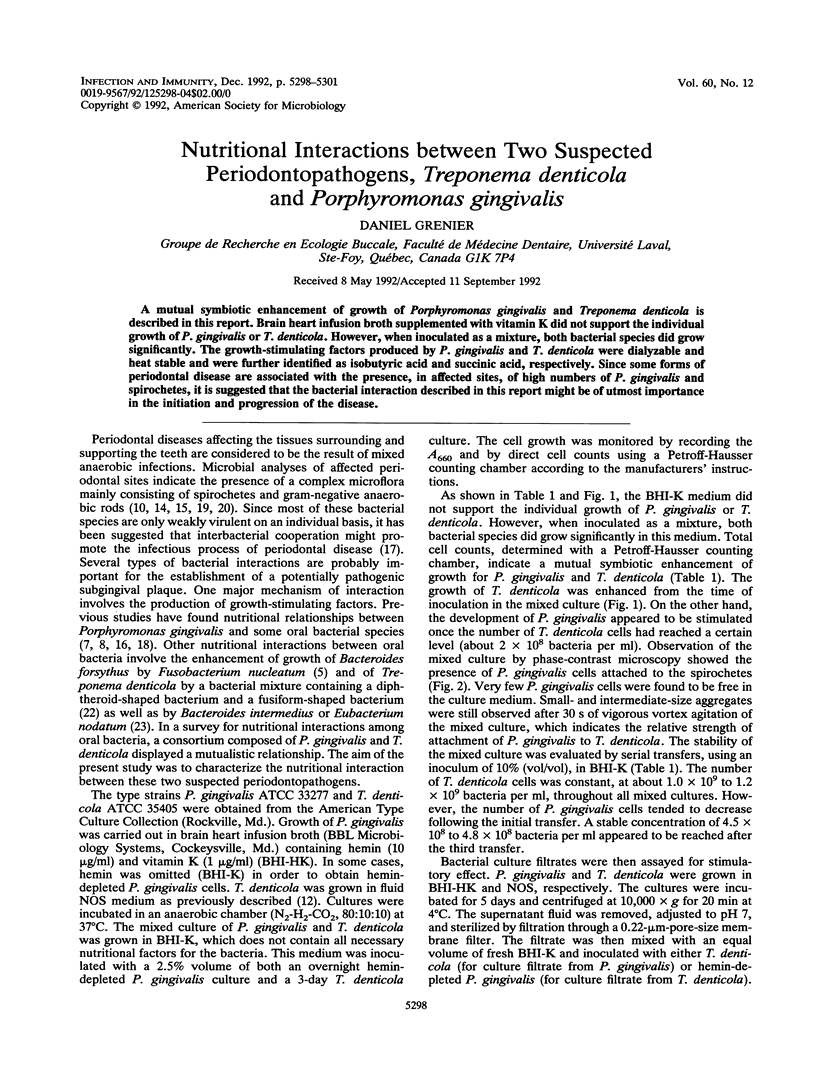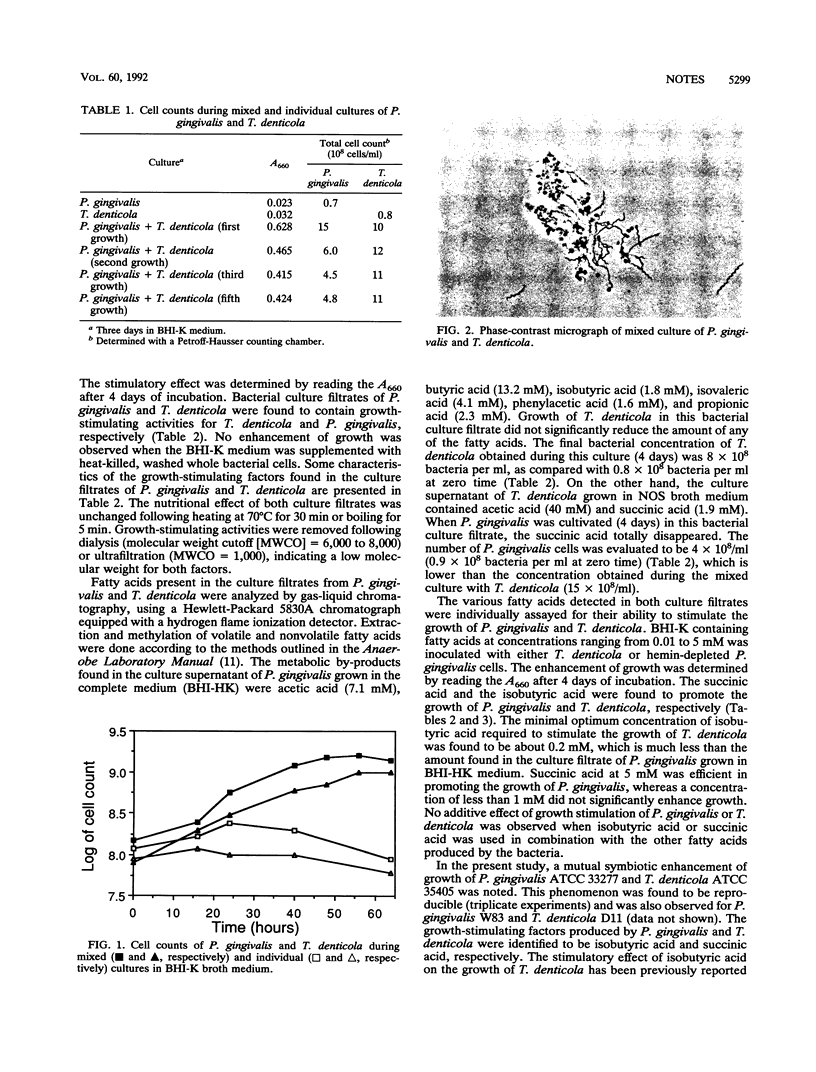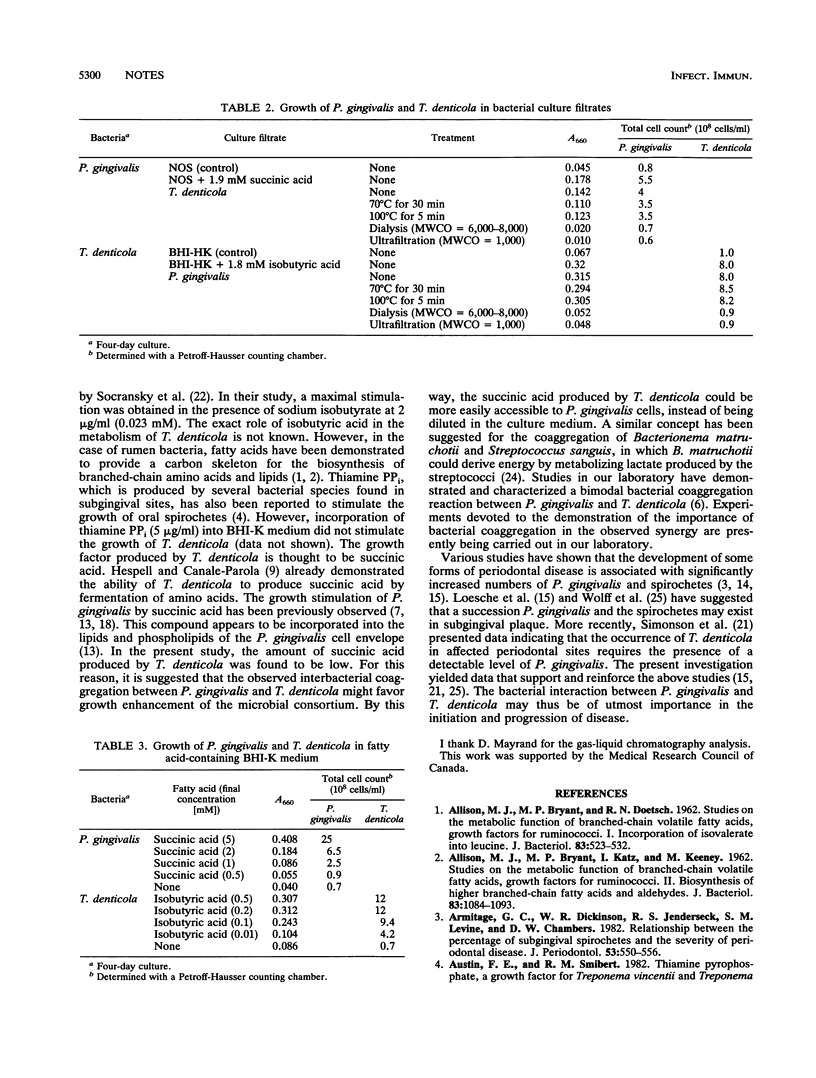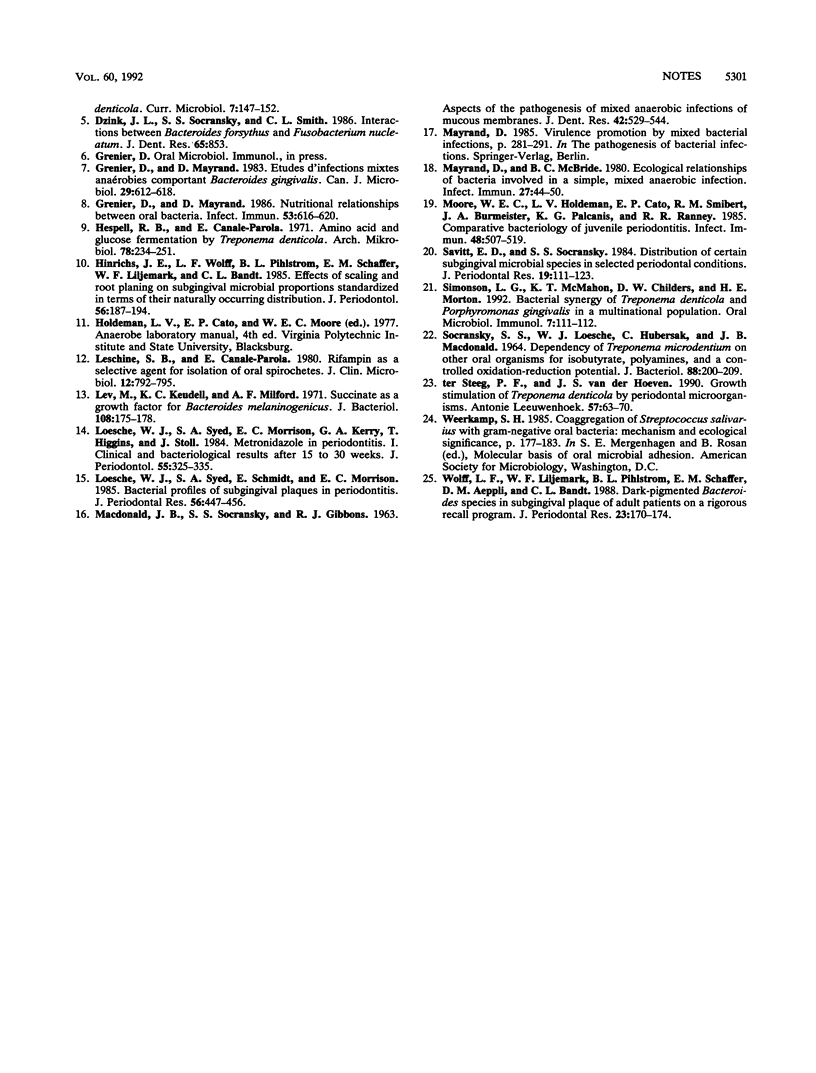Abstract
A mutual symbiotic enhancement of growth of Porphyromonas gingivalis and Treponema denticola is described in this report. Brain heart infusion broth supplemented with vitamin K did not support the individual growth of P. gingivalis or T. denticola. However, when inoculated as a mixture, both bacterial species did grow significantly. The growth-stimulating factors produced by P. gingivalis and T. denticola were dialyzable and heat stable and were further identified as isobutyric acid and succinic acid, respectively. Since some forms of periodontal disease are associated with the presence, in affected sites, of high numbers of P. gingivalis and spirochetes, it is suggested that the bacterial interaction described in this report might be of utmost importance in the initiation and progression of the disease.
Full text
PDF



Images in this article
Selected References
These references are in PubMed. This may not be the complete list of references from this article.
- ALLISON M. J., BRYANT M. P., DOETSCH R. N. Studies on the metabolic function of branched-chain volatile fatty acids, growth factors for ruminococci. I. Incorporation of isovalerate into leucine. J Bacteriol. 1962 Mar;83:523–532. doi: 10.1128/jb.83.3.523-532.1962. [DOI] [PMC free article] [PubMed] [Google Scholar]
- ALLISON M. J., BRYANT M. P., KATZ I., KEENEY M. Metabolic function of branched-chain volatile fatty acids, growth factors for ruminococci. II. Biosynthesis of higher branched-chain fatty acids and aldehydes. J Bacteriol. 1962 May;83:1084–1093. doi: 10.1128/jb.83.5.1084-1093.1962. [DOI] [PMC free article] [PubMed] [Google Scholar]
- Armitage G. C., Dickinson W. R., Jenderseck R. S., Levine S. M., Chambers D. W. Relationship between the percentage of subgingival spirochetes and the severity of periodontal disease. J Periodontol. 1982 Sep;53(9):550–556. doi: 10.1902/jop.1982.53.9.550. [DOI] [PubMed] [Google Scholar]
- Grenier D., Mayrand D. Etudes d'infections mixtes anaérobies comportant Bacteroides gingivalis. Can J Microbiol. 1983 May;29(5):612–618. [PubMed] [Google Scholar]
- Grenier D., Mayrand D. Nutritional relationships between oral bacteria. Infect Immun. 1986 Sep;53(3):616–620. doi: 10.1128/iai.53.3.616-620.1986. [DOI] [PMC free article] [PubMed] [Google Scholar]
- Hespell R. B., Canale-Parola E. Amino acid and glucose fermentation by Treponema denticola. Arch Mikrobiol. 1971;78(3):234–251. doi: 10.1007/BF00424897. [DOI] [PubMed] [Google Scholar]
- Hinrichs J. E., Wolff L. F., Pihlstrom B. L., Schaffer E. M., Liljemark W. F., Bandt C. L. Effects of scaling and root planing on subgingival microbial proportions standardized in terms of their naturally occurring distribution. J Periodontol. 1985 Apr;56(4):187–194. doi: 10.1902/jop.1985.56.4.187. [DOI] [PubMed] [Google Scholar]
- Leschine S. B., Canale-Parola E. Rifampin as a selective agent for isolation of oral spirochetes. J Clin Microbiol. 1980 Dec;12(6):792–795. doi: 10.1128/jcm.12.6.792-795.1980. [DOI] [PMC free article] [PubMed] [Google Scholar]
- Lev M., Keudell K. C., Milford A. F. Succinate as a growth factor for Bacteroides melaninogenicus. J Bacteriol. 1971 Oct;108(1):175–178. doi: 10.1128/jb.108.1.175-178.1971. [DOI] [PMC free article] [PubMed] [Google Scholar]
- Loesche W. J., Syed S. A., Morrison E. C., Kerry G. A., Higgins T., Stoll J. Metronidazole in periodontitis. I. Clinical and bacteriological results after 15 to 30 weeks. J Periodontol. 1984 Jun;55(6):325–335. doi: 10.1902/jop.1984.55.6.325. [DOI] [PubMed] [Google Scholar]
- Loesche W. J., Syed S. A., Schmidt E., Morrison E. C. Bacterial profiles of subgingival plaques in periodontitis. J Periodontol. 1985 Aug;56(8):447–456. doi: 10.1902/jop.1985.56.8.447. [DOI] [PubMed] [Google Scholar]
- Mayrand D., McBride B. C. Exological relationships of bacteria involved in a simple, mixed anaerobic infection. Infect Immun. 1980 Jan;27(1):44–50. doi: 10.1128/iai.27.1.44-50.1980. [DOI] [PMC free article] [PubMed] [Google Scholar]
- Moore W. E., Holdeman L. V., Cato E. P., Smibert R. M., Burmeister J. A., Palcanis K. G., Ranney R. R. Comparative bacteriology of juvenile periodontitis. Infect Immun. 1985 May;48(2):507–519. doi: 10.1128/iai.48.2.507-519.1985. [DOI] [PMC free article] [PubMed] [Google Scholar]
- SOCRANSKY S. S., LOESCHE W. J., HUBERSAK C., MACDONALD J. B. DEPENDENCY OF TREPONEMA MICRODENTIUM ON OTHER ORAL ORGANISMS FOR ISOBUTYRATE, POLYAMINES, AND A CONTROLLED OXIDATION-REDUCTION POTENTIAL. J Bacteriol. 1964 Jul;88:200–209. doi: 10.1128/jb.88.1.200-209.1964. [DOI] [PMC free article] [PubMed] [Google Scholar]
- Savitt E. D., Socransky S. S. Distribution of certain subgingival microbial species in selected periodontal conditions. J Periodontal Res. 1984 Mar;19(2):111–123. doi: 10.1111/j.1600-0765.1984.tb00800.x. [DOI] [PubMed] [Google Scholar]
- Simonson L. G., McMahon K. T., Childers D. W., Morton H. E. Bacterial synergy of Treponema denticola and Porphyromonas gingivalis in a multinational population. Oral Microbiol Immunol. 1992 Apr;7(2):111–112. doi: 10.1111/j.1399-302x.1992.tb00519.x. [DOI] [PubMed] [Google Scholar]
- Wolff L. F., Liljemark W. F., Pihlstrom B. L., Schaffer E. M., Aeppli D. M., Bandt C. L. Dark-pigmented Bacteroides species in subgingival plaque of adult patients on a rigorous recall program. J Periodontal Res. 1988 May;23(3):170–174. doi: 10.1111/j.1600-0765.1988.tb01353.x. [DOI] [PubMed] [Google Scholar]
- ter Steeg P. F., van der Hoeven J. S. Growth stimulation of Treponema denticola by periodontal microorganisms. Antonie Van Leeuwenhoek. 1990 Feb;57(2):63–70. doi: 10.1007/BF00403156. [DOI] [PubMed] [Google Scholar]



